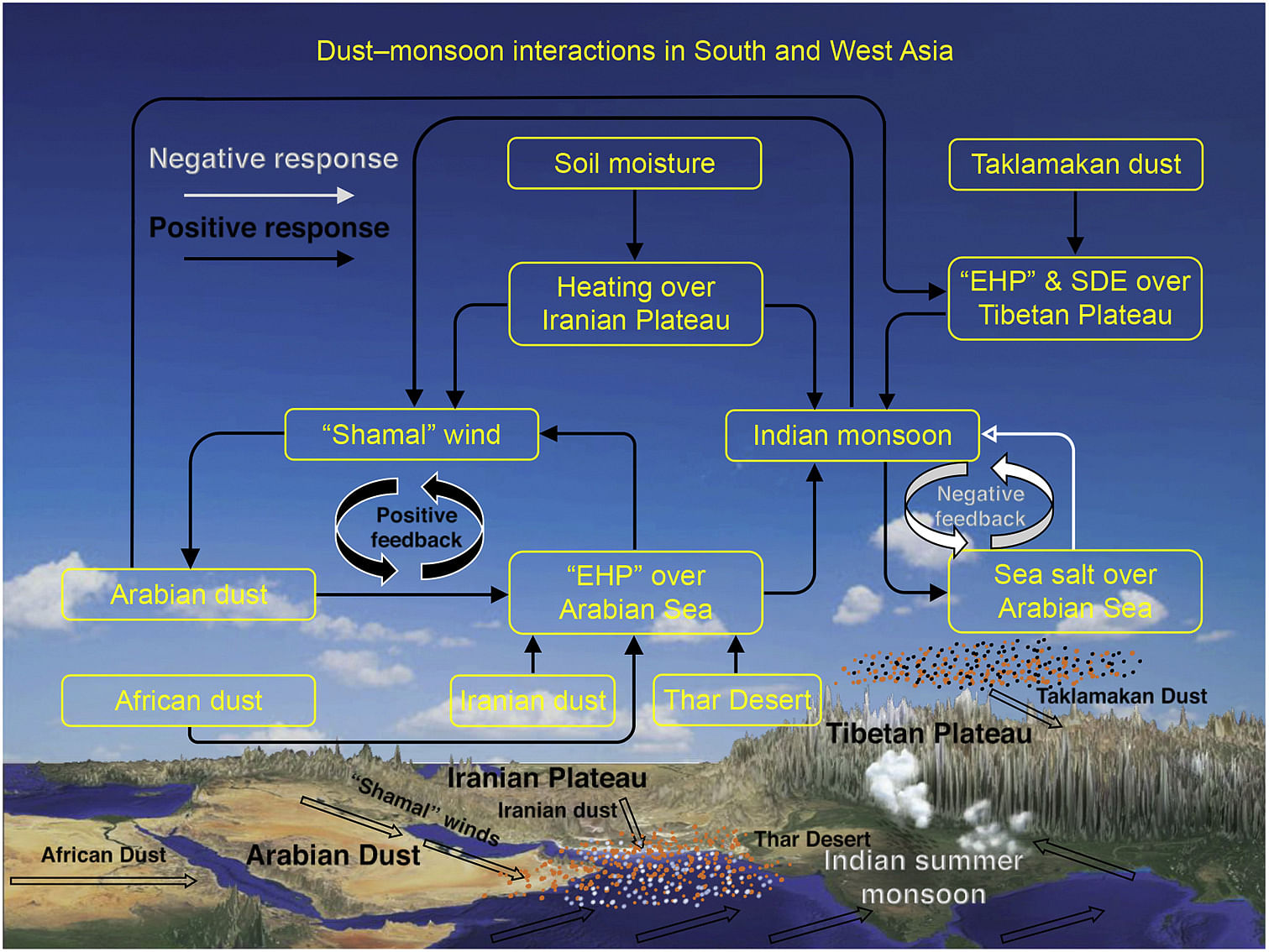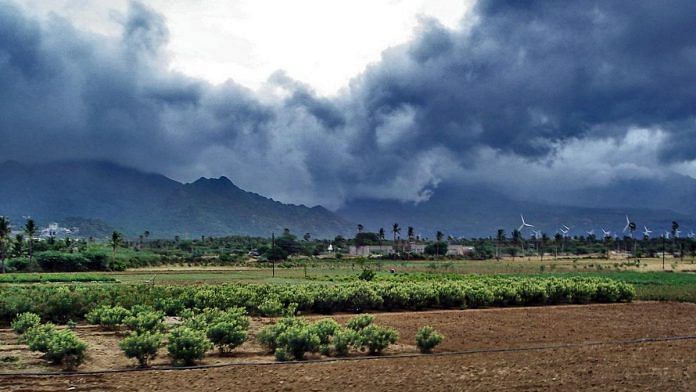The Indian summer monsoon, also known as the South Asian summer monsoon, is one of the world’s strongest monsoon systems. At the end of May and in early June, the meridional shift of the subsolar point drives the northward propagation of the Inter Tropical Convergence Zone (ITCZ), which brings abundant moist air from the Southern Hemisphere to the Northern Hemisphere causing strong convection over the Northern Indian Ocean. As the subsolar point and ITCZ propagate further north in mid-June, the Indian subcontinent warms up by absorption of the increasing solar radiation at a greater rate than the Indian Ocean does, forming a strong ocean–land thermal gradient, which drives strong low-level southwesterly winds that transport water vapour from the tropical Indian Ocean and the Arabian Sea towards the Indian subcontinent.
The sensible heat flux from the Earth’s surface to the atmosphere over the vast Eurasian Continent, especially over the Tibetan Plateau and the Iranian Plateau, further strengthen the Indian summer monsoon (ISM) circulation by increasing the south–north temperature gradient in the mid-troposphere in July. This sensible heat together with the strong latent heat released from intense monsoon convection drives the ISM to reach its peak in July and August. As the ITCZ moves southward in August, the ISM demises in September.
Besides the dominant roles of the ITCZ and ocean–land thermal contrast playing in the ISM system, aerosols from both natural and anthropogenic emissions can further modulate the ISM system. The heavy aerosol layers (mainly anthropogenic aerosols, including black carbon and sulphate) over South Asia can cool the surface by scattering and absorbing solar radiation, which reduces the ocean–land thermal contrast and in turn weakens the ISM, the so-called “solar dimming” or “global dimming” effect. On the other hand, absorbing aerosols (e.g., black carbon and mineral dust) that accumulate over the southern slope of the Tibetan Plateau can heat the mid-troposphere, pumping the air from South to North India and strengthening monsoon convection over North India. This is referred to as the “elevated heat pump (EHP)” effect.
Moreover, absorbing aerosols can also modulate the meridional gradient of sub-cloud moist static energy (MSE) over the Indian subcontinent and shift the monsoonal deep convection northwestward. When deposited on snow and ice on the Tibetan Plateau, these absorbing aerosols change land surface albedo and energy budget, modifying the circulation and precipitation over both the ISM and East Asian monsoon regions. These different and competing effects of aerosols on the ISM have confounded aerosol–monsoon interactions and spurred debates about whether aerosols strengthen or weaken the ISM system.

Recently, studies found that remote dust aerosols from the Middle East can also strongly modulate the variability of ISM system. Figure 1 shows the summertime aerosol optical depth (AOD) climatology in this region. Over the Arabian Peninsula and the northwestern Arabian Sea, more than 50% of the AOD is contributed by mineral dust. Tons of dust aerosols emitted from the Arabian Peninsula and its surrounding areas are transported to the Arabian Sea by the strong northwesterly “Shamal” winds during boreal summer. These dust aerosols over the Arabian Sea could heat the lower and mid-troposphere, forming a heat low over the Arabian Sea. This heat low strengthens the southwestern monsoon branch, which favours the moisture transport from the Arabian Sea to the Indian subcontinent and in turn increases rainfall in most parts of the Indian subcontinent.
Although most studies agree that the Middle East dust aerosols can strengthen the ISM system by heating the troposphere, they demonstrate large discrepancies in the ISM rainfall responses in terms of spatial pattern and magnitude. Observations showed that AOD over the Arabian Sea and the southern Arabian Peninsula is significantly and positively correlated with the ISM rainfall in the southwest coastal regions, Northern Central India, and the southern slope of the Tibetan Plateau. A global model simulation showed that the monsoonal rainfall responses to dust are negative in Northeast India yet positive in South India.
Also read: India’s water crisis is forcing farmers to finally rethink what they grow
Topographic heating over the Iranian Plateau
One possible physical mechanism linking the Arabian dust and the ISM rainfall at the interdecadal timescale is through the thermal forcing of the Iranian Plateau. The summertime temperature in the mid-troposphere over the Iranian Plateau was found to be positively correlated with 1) the ISM rainfall at the interdecadal timescale from 1967 to 2015 and 2) the summertime near-surface Shamal wind and AOD over the Arabian Peninsula and the Arabian Sea from 2000 to 2013.
Therefore, here we propose another hypothesis that the observed positive dust–monsoon correlation could be partially attributed to the heating over the Iranian Plateau, which could enhance the dust emissions over the Arabian Peninsula through strengthening the Shamal winds as well as the ISM circulations and rainfall at the interdecadal timescale. Numerous factors could contribute to the mid-troposphere temperature variations over the Iranian Plateau, and further studies are needed to identify them. However, it is worth mentioning that dust and soil moisture are two potential factors that can influence the mid-troposphere temperature over the Iranian Plateau.
Also read: India received third-highest rainfall on record this year, August was wettest in 44 years
Conclusion
We have identified several physical mechanisms behind the interactions of Asian mineral dust aerosols with the Indian summer monsoon rainfall, and the broad scale ASM, and also addressed the current challenges in numerical simulations of dust physical and chemical properties and the associated climatic impacts at the global scale.

The Asian dust–ISM monsoon interactions involve complex interactions of dust, clouds, circulation, convection and precipitation, as summarised in Figure 2. Dust aerosols accumulated over the Arabian Sea during the monsoon season are transported from four sources: the Arabian Peninsula, Iran–Afghanistan–Pakistan, the Thar Desert, and the Horn of Africa. These transported dust aerosols can be readily lifted to a high altitude and get stacked over the Arabian Sea along the inter-tropical discontinuity areas (i.e., with near-zero meridional wind), which is formed by the concurrent of northwesterly Shamal wind and northerly Levar wind from land mass and southwesterly monsoon flow from ocean. Radiative heating through the stacked effect of dust aerosols could induce diabatic heating–dynamical feedback analogous to the EHP. This results in a strengthening of the northwest Shamal wind and an enhancement of the southwest monsoonal flow. A stronger Shamal wind can cause more dust emissions, forming a positive feedback loop between dust induced EHP effect over the Arabian Sea and the Shamal wind.
On the other hand, the strengthened southwest monsoonal flow can generate more sea salt aerosols, which can exert a negative impact on the monsoonal circulations and rainfall through scattering solar radiation and thus cooling the mid-troposphere, which in turn reduces sea salt emissions. As a result, a negative feedback loop exists between the southwest monsoonal flow and sea salt over the Arabian Sea. The observed positive correlation between the monsoonal rainfall and AOD over the Arabian Sea indicates that the positive feedback loop between Shamal wind and the dust induced EHP effect dominates the negative feedback loop between the southwest monsoonal flow and sea salt emissions. Snow-darkening effect (SDE), caused by the deposition of black carbon and dust in snow and ice in the high terrains of the Iranian Plateau and the western Tibetan Plateau during boreal spring and early summer, can also reduce the snow albedo and warm the land surface and subsequently the troposphere. A warmer troposphere due to SDE over the Tibetan Plateau can further amplify the EHP effect and modulate the rainfall patterns of the ISM and EASM, through displacement of the jet stream, and development of upper-level wave-train teleconnections.
Additionally, topographic heating over the Iranian Plateau could further strengthens the summer Shamal wind and thus enhance dust emissions and dust transport to the Arabian Sea. This heating has been long recognised as one of the drivers for the initialisation and development of the ISM system. Dust accumulation over the southern foothills of the Iranian Plateau and West Himalayas can also be effective in inducing EHP dynamical feedback. Therefore, both dust emissions in the Arabian Peninsula and the monsoonal rainfall could be enhanced by a stronger heating over the Iranian Plateau, which could be an important physical mechanism responsible for the observed positive correlation between AOD over the Arabian Sea and monsoonal rainfall.
Qinjian Jin is a lecturer in the Department of Geography and Atmospheric Science at University of Kansas
Jiangfeng Wei is professor at the Nanjing University of Information Science and Technology, China;
William K. M. Lau is a senior research scientist at ESSIC and adjunct professor of the Department of Atmospheric and Oceanic Sciences, University of Maryland.
Bing Pu is assistant professor of geography & atmospheric science at KU
Chien Wang of Laboratoire d’Aerologie, France is also a senior research scientist at the Massachusetts Institute of Technology (MIT).
This is an edited excerpt from the authors’ paper first published in Earth-Science Reviews. Read the full paper here.







Conclusions, what a general farmer can decide is rains in summer. What sense Troogle Google
A very good scientific article. It should be presented in a simple manner for the benefit of general public like an 8th standard geography book explaining Indian moonsoon to high school kids.
End of the day- What is effect of this on Indian mansion? Lot of data but no inference.